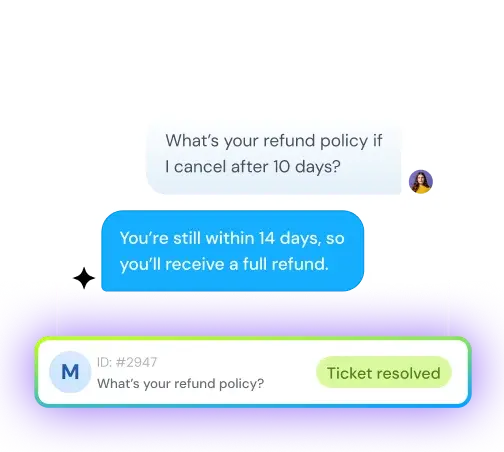How to reduce customer service ticket backlog: 6 practical tips
Sneha Arunachalam
Sep 11, 2025
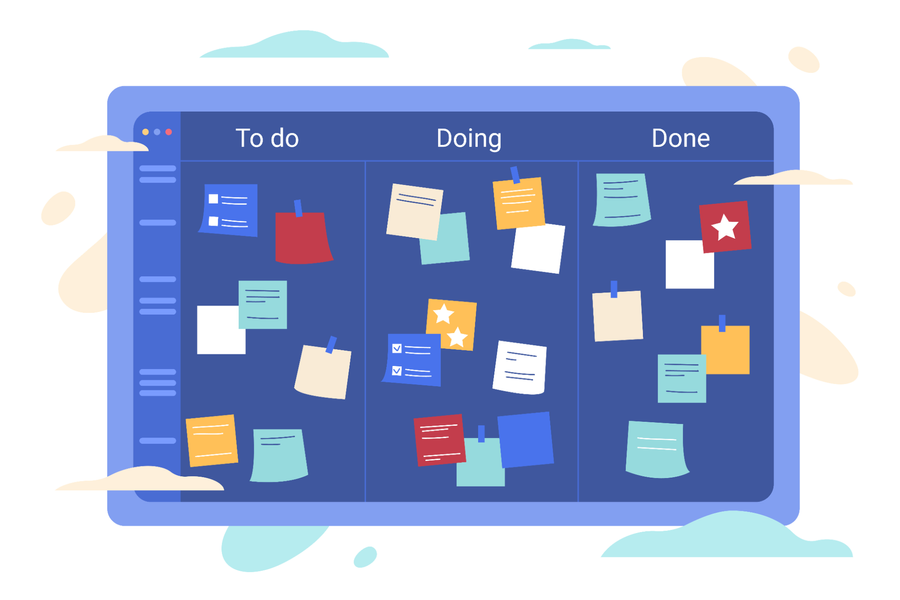
Every unanswered customer query is more than just a ticket — it’s a missed opportunity, a frustrated customer, and a stressed agent. When tickets pile up, response times slip, satisfaction drops, and your team risks burnout.
So how do you actually fix this without burning out your team? You need strategies that work in the real world, not just on paper.
Think of this blog as your toolkit for getting ahead of the chaos. We'll walk through six practical ways to shrink that backlog and make your support operations actually manageable. From figuring out what's really causing all those tickets to keeping your team motivated when things get crazy — these aren't theories, they're techniques that help you handle customer requests without losing your mind.
The result? Your customers get better help, your team stays sane, and your whole operation runs smoother.
What is a customer service ticket backlog?
A customer service ticket backlog is all those unresolved support requests sitting in your queue longer than they should be. It's not just having open tickets — we're talking about the ones that have blown past your normal response times, creating a growing pile that demands attention.
Picture your support system like a busy coffee shop during morning rush. When orders come in faster than your baristas can make them, drinks start backing up on the counter. Those waiting drinks? That's your backlog.
What creates a ticket backlog?
A few things can turn your smooth operation into chaos:
- Not enough people on your team or poor ticket prioritization
- Sudden spikes from sales, holidays, or that viral social media post
- Tricky issues that need detective work across multiple departments
- Team members out sick or new hires still learning the ropes
- Product meltdowns — outages, bugs, or recalls that send everyone scrambling
- Clunky processes that slow everything down
Is zero backlog the goal?
Here's something that might surprise you — completely clearing your backlog isn't actually ideal. Support experts say "having a ticket queue of zero isn't exactly healthy". A small backlog shows your team is appropriately busy without being overwhelmed.
Teams with manageable backlogs actually get better at:
- Figuring out what needs attention first
- Handling everything from quick fixes to complex problems
- Balancing urgent stuff with the trickier cases
- Spreading work evenly across the team
As support management experts put it, "some sort of backlog is to be expected" once you're up and running. The trick is knowing the difference between healthy and out-of-control.
Measuring backlog effectively
Your backlog calculation depends on whatever promises you've made customers. If your SLA says 24-hour responses, then anything sitting there longer becomes part of your backlog. Say you've got 50 tickets out of 500 that haven't been answered after 24 hours — that's a 10% backlog.
Every ticket represents someone waiting, and support leaders remind us that "every open case means you have a customer waiting to be satisfied and each case has a 'holding cost'". That cost keeps climbing the longer issues sit there.
You'll also want to distinguish between:
- Unanswered tickets (might mean you need more people)
- Unresolved tickets (could signal training gaps or process problems)
Why backlog matters
Your backlog tells a story about how things are really going. Tracking it helps you:
- Spot which areas are falling behind
- Get a read on overall customer happiness
- Notice patterns in what's breaking or confusing people
- See how well you're actually meeting customer needs
High backlogs usually mean longer waits, which leads to frustrated customers who might just walk away. But consistently low backlogs (not zero, remember) show your team can handle what comes their way while maintaining standards.
Understanding what makes up your backlog gives you the foundation for actually doing something about it. Without this insight, you're just guessing at solutions.
Before we dive into the actual tactics to reduce ticket backlog, it’s worth calling out one solution that consistently moves the needle for teams drowning in open tickets. And that’s SparrowDesk.
Its AI instantly auto-resolves up to 60% of repetitive queries, preventing backlog from ballooning in the first place. For everything else, SparrowDesk’s intelligent routing and seamless agent handoff keep tickets moving instead of getting stuck.
You also get real-time backlog insights, aging tickets, SLA risks, and bottlenecks highlighted automatically—so your team can fix issues before they pile up. It’s a simple way to stay ahead of your queue instead of chasing it.
Sign up for a free 14-day trial and see how SparrowDesk reduces backlog from day one.
14-day free trial • Cancel Anytime • No Credit Card Required • No Strings Attached
Tip 1: Analyze the structure of your ticket backlog
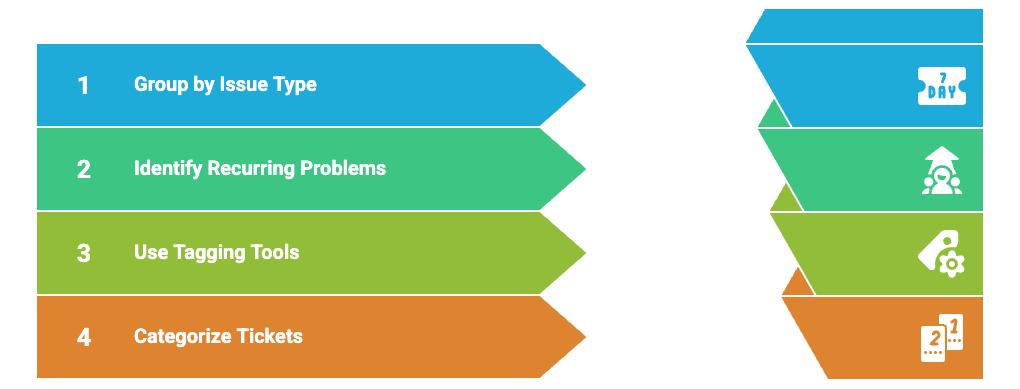
Here's the thing — diving straight into clearing tickets without understanding what's causing them is like bailing water from a sinking boat without plugging the hole.
Group tickets by issue type
Think of your backlog like a messy closet. Everything's there, but you can't find what you need until you sort it into actual categories.
Start by analyzing historical support requests to spot the patterns. Maybe 40% of your tickets are about delivery problems, or everyone's confused by the same feature. These insights show you exactly which buckets to create.
Smart teams align their categories with how their product and engineering teams actually work. If your product folks organize around inbox, analytics, and workflow automation, your ticket categories should match that structure. Don't create some generic system that cuts across departments — that just makes everything harder.
Try breaking things down by:
- Issue type (bugs, account access, billing questions)
- Priority level (critical, high, medium, low)
- Required teams (engineering, customer success, billing)
Keep it simple at first! You can always get fancier later, but starting with too many categories just creates confusion.
Identify recurring problems
This is where the real magic happens. Sure, clearing individual tickets helps customers right now. But spotting the patterns that create tickets? That prevents them from happening in the first place.
Set up something to track complaints — could be a simple spreadsheet or your ticketing system with tags. The goal is separating one-off weird issues from the stuff that keeps coming up.
Look at your categorized data regularly to catch trends early. You'll start seeing:
- Customer issues before they blow up
- Which parts of your product trip people up most
- Where your help desk process falls apart
Don't just count tickets — dig into why people are reaching out about specific features. The more specific you get about root causes, the more your product team can actually fix.
Here's an example: if 30% of your backlog is account access problems, you need to figure out if it's confusing password rules, a buggy login flow, or terrible self-service options.
Use tagging and categorization tools
Without proper tagging, trying to analyze your backlog becomes a nightmare for everyone.
Modern AI can automatically categorize and tag tickets as they come in, which means:
- Every ticket gets classified the same way
- No waiting around for manual sorting
- You get insights without the grunt work
Good tags give your agents instant context about what they're dealing with. Consider tagging for:
- Issue type (product issue, billing question)
- Priority level (urgent, low priority)
- Customer type (individual, enterprise client)
- Product/service involved
- Resolution stage
Stay consistent with your tags. If "Product Issue" is your standard, don't let people use "Prod Issue" or "P. Issue". Consistency is what makes the data actually useful.
Once you've got your backlog properly analyzed and organized, you'll know exactly where to focus your improvement efforts instead of just randomly fighting fires.
If you want a faster way to analyze and categorize backlog without all the manual sorting, try SparrowDesk’s AI-powered ticketing system.
Sign up for a free 14-day trial and see the difference.
14-day free trial • Cancel Anytime • No Credit Card Required • No Strings Attached
Tip 2: Improve self-service options
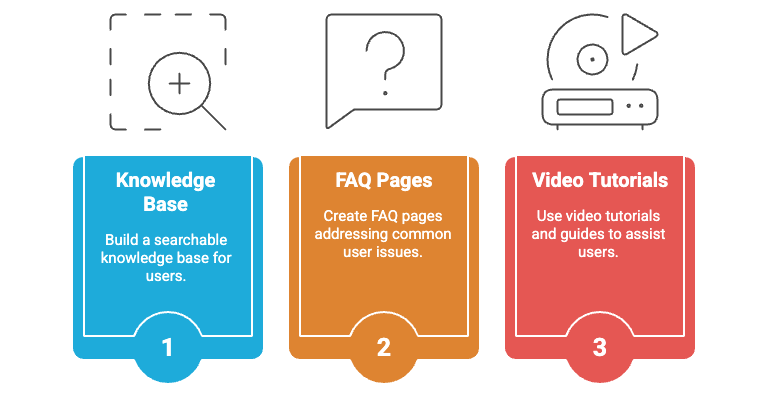
Here's something interesting — 81% of consumers want more self-service options, but only 15% actually feel good about what's currently available. That gap? It's your opportunity to cut down on tickets before they even hit your queue.
Build a searchable knowledge base
Think of a knowledge base like having a really smart friend who's available 24/7 to answer questions about your product. It's your central spot for articles, tutorials, FAQs, and troubleshooting guides that let customers help themselves.
Here's what makes one actually work:
- Keep everything organized with clear categories and tags
- Write like you're talking to a person, not a manual
- Make sure the search actually finds what people need
- Put it where customers can't miss it on your site
A solid knowledge base doesn't just help customers — it saves your team from answering the same questions over and over. But here's the catch: outdated info makes things worse. Employees keep running into stale product information, so keeping everything current isn't optional.
Create FAQ pages for common issues
FAQ pages are different from your full knowledge base — they're quick hits for the stuff people ask about most. Keep them short and get straight to the point.
Use your actual ticket data to figure out what questions come up again and again. Then organize those answers so people can scan and find what they need fast. 75% of people say self-service is the most convenient way to solve problems, which means good FAQs can stop a lot of tickets before they start.
Use video tutorials and guides
Some people just learn better by watching. Customers would rather watch a short video than read through instructions — and that makes sense for things like product setup or walking through features.
Videos work great for:
- Showing exactly how something works
- Walking through setup steps
- Explaining tricky features
- Fixing common problems
Want something even better? Interactive tutorials let people actually practice while they learn.
When you combine all three approaches — knowledge base, FAQs, and videos — you create a system that handles routine questions automatically. Your team gets to focus on the complex stuff that actually needs human help, and your backlog shrinks naturally.
If you want all of this built in smart search, auto-suggested articles, and AI-powered ticket deflection — SparrowDesk makes self-service actually work. Try it free for 14 days.
14-day free trial • Cancel Anytime • No Credit Card Required • No Strings Attached
Tip 3: Use automation to reduce support tickets
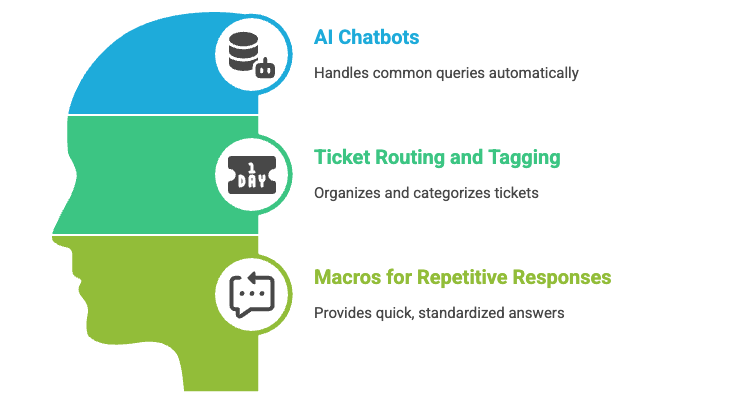
Automation isn't just a buzzword — it's your secret weapon against an out-of-control ticket queue. The right automated customer support tools let your team handle way more requests without adding headcount or working weekends.
Set up AI chatbots for common queries
Think of chatbots as your always-on support team members who never get tired or need coffee breaks. Modern AI chatbots actually understand what customers are asking and can provide helpful answers across all your channels.
Here's what you get when you set them up right:
- Round-the-clock help regardless of time zones or holidays
- Instant responses — no more "we'll get back to you"
- Handle tons of conversations at once
- Absorb those sudden ticket spikes without breaking a sweat
The results speak for themselves. HelloSugar (a salon chain) now handles 66% of customer questions with AI, saving $14,000 monthly and opening new locations without hiring more support staff. Lush does something similar — their chatbots tackle the routine stuff so human agents can focus on the tricky problems that actually need a person.
Automate ticket routing and tagging
Nobody wants to spend their day playing ticket traffic cop. Automated routing fixes this by instantly sending each ticket to the right person based on what the issue actually is.
Smart routing systems look at keywords, categories, and priority levels, then send tickets exactly where they need to go. This cuts first response time and makes sure urgent stuff gets handled fast.
Same goes for tagging — let the system scan ticket descriptions and apply the right tags automatically. Your backlog stays organized, and you can set up workflows that actually make sense.
Use macros for repetitive responses
We've all been there — typing the same response for the hundredth time this week. Macros solve this by storing your go-to answers and actions so you can apply them with just a click.
Macros can handle:
- Adding your standard response text
- Updating ticket fields automatically
- Adding or removing tags
- Changing status and priority
But here's the real win: consistency. Every customer gets the same quality response regardless of which agent picks up their ticket. No more wondering if someone's having an off day.
Put these automation pieces together, and you've got a support system that actually works with you instead of against you. Customers get faster help, your team stays sane, and that backlog becomes way more manageable.
For customer service automation that cuts tickets instead of creating more work, give SparrowDesk a try.
Start your 14 day free trial today
14-day free trial • Cancel Anytime • No Credit Card Required • No Strings Attached
Tip 4: Prioritize and triage tickets effectively
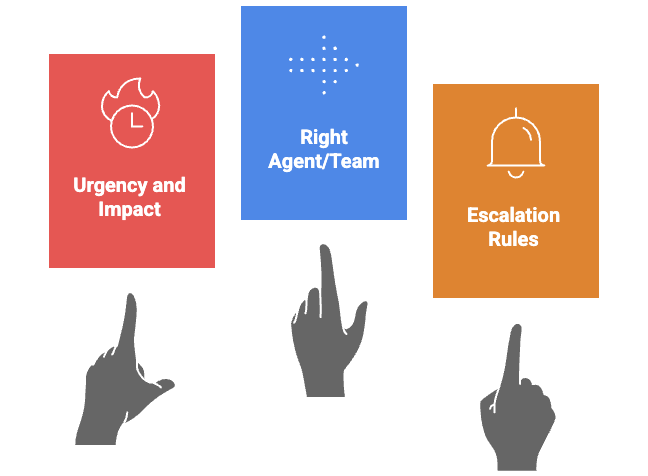
When your queue feels chaotic, proper prioritization is what turns the mess into something manageable. Getting this right means your team tackles the most critical issues first instead of just grabbing whatever's on top.
Assign based on urgency and impact
ITIL defines ticket priority as impact multiplied by urgency. Sounds fancy, but it's actually pretty straightforward — you're just asking two questions:
- Impact: How many people or business processes does this affect?
- Urgency: How fast does this need fixing?
Think of it like this: a simple priority matrix helps you decide what deserves immediate attention:
Low Impact | Medium Impact | High Impact | |
Low Urgency | Low Priority | Medium Priority | Medium Priority |
Medium Urgency | Low Priority | Medium Priority | High Priority |
High Urgency | Medium Priority | High Priority | High Priority |
High-impact tickets hit multiple users or mess with critical business stuff, while high-urgency issues need fixing right now to prevent bigger problems. The high-priority tickets get handled first — then you work your way down to medium and low priority.
Here's what works in practice:
- High Priority: Fix within 1-2 hours
- Medium Priority: Resolve within 24-48 hours
- Low Priority: Handle within 3-5 business days
Route to the right agent or team
Once you know what's urgent, get those tickets to the people who can actually solve them. No point sending billing questions to your tech team.
You've got a few routing options:
- Skill-based routing: Match tickets to agents who know that stuff
- Load-balanced routing: Spread the work evenly so nobody gets swamped
- Round-robin assignment: Take turns so it's fair
Most helpdesk systems can handle this automatically, looking at things like who's available, what they're good at, and how busy they are. This prevents one person from drowning in tickets while someone else sits around.
Use escalation rules for critical issues
Even with good prioritization, some tickets need extra attention. Set up clear escalation rules for when:
- A ticket sits unresolved past your promised timeframe
- Something breaks that affects core business operations
- One problem starts hitting multiple customers
Time-based escalation works really well:
- First escalation: After 4 hours, bump to a senior team member
- Second escalation: After 8 hours, get management involved
- Critical escalation: Anything unresolved for 12+ hours goes to the top level
These safety nets make sure nothing gets forgotten, especially when things get crazy busy. Plus, automated alerts can warn managers when you're about to miss those SLAs.
Getting prioritization and triage right directly affects how well you handle your backlog — and how happy both your customers and team stay when the pressure's on.
Tip 5: Motivate your support team
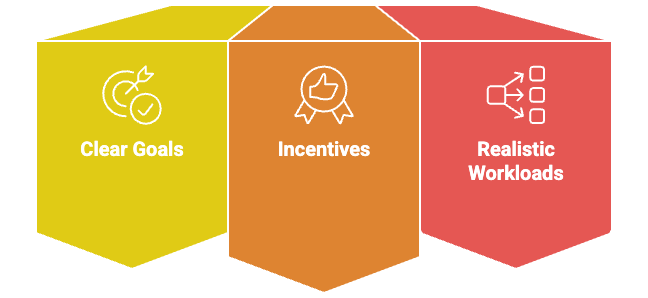
Here's the thing — your support team deals with frustrated customers all day long. Keeping your people motivated isn't just nice to have, it's essential for actually solving your backlog problem.
Set clear goals and milestones
Vague directions create stress. Nobody wants to spend their day wondering if they're doing a good job or what they should focus on next. That's why specific, measurable goals work so much better — your team knows exactly what success looks like.
But here's what really helps fight burnout: showing people where they're headed. Map out exactly how someone can move from answering tickets to leading a team or becoming a specialist. This matters more than you might think, especially since only 6% of Gen Z workers prioritize becoming top leaders as their main career goal. They want to see growth, just not necessarily the traditional ladder.
Offer incentives and recognition
Sometimes a simple "well done" makes someone's whole week. We totally get that support work can feel thankless, so recognition becomes huge.
Beyond verbal praise, try:
- Digital gift cards for hitting weekly targets
- Extra PTO for stellar customer ratings
- Team outings that actually build connection
- Public shoutouts for great work
Avoid burnout with realistic workloads
Watch your metrics for warning signs — both plummeting productivity and crazy overtime hours can signal someone's about to burn out.
Here's how to keep workloads manageable:
- Actually review capacity versus ticket volume regularly
- Use automation to distribute tickets fairly
- Build self-service options so agents aren't answering the same basic questions all day
- Teach your team to help customers use those self-service tools
Most importantly, create space where people can actually say when they're overwhelmed without worrying about their job. When your team feels safe being honest about their workload, you can fix problems before they explode into bigger issues.
Tip 6: Use dashboards and metrics to stay on track
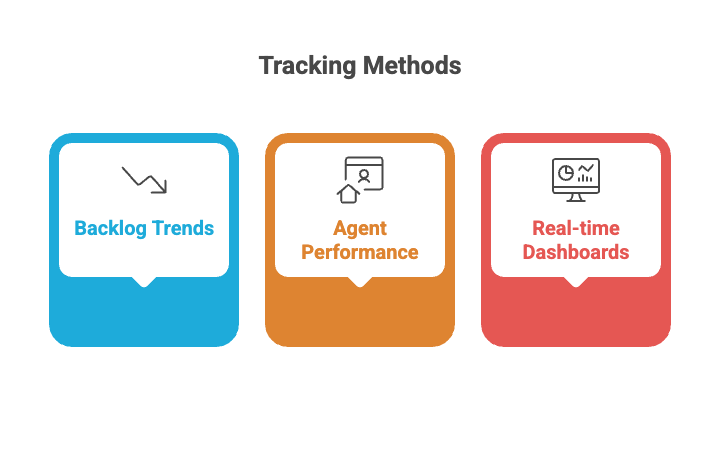
Think of it like this: if your support operation is like running a busy restaurant, dashboards are your kitchen display system showing which orders are ready, which are taking too long, and where the bottlenecks are happening.
Raw numbers sitting in spreadsheets won't help you when things get crazy. You need visual data that shows you what's actually going on so you can make smart decisions before small problems turn into major headaches.
Track backlog trends over time
Here's the thing — looking at your backlog number just once doesn't tell you much. You need to see how it changes over time to spot the real patterns that matter. Many teams miss seasonal spikes, gradual increases, or sudden drops that reveal important trends about their operation.
Visual graphs make these patterns jump out at you immediately:
- Weekly views show your regular rhythm
- Monthly trends highlight busy periods
- Yearly data reveals seasonal patterns you might not expect
When your backlog consistently grows faster than your team can handle tickets, that's your early warning system. Time to add staff, automate more processes, or figure out what's causing the surge.
Monitor agent performance
Individual performance dashboards show you who's crushing it and who might need help. Track things like response times, resolution speed, and how well everyone's hitting their targets. This isn't about being the performance police — it's about spotting problems before they get worse.
Watch for the extremes. Both slacking productivity and working crazy overtime hours can signal someone's headed for burnout.
Here's a real example: one manager noticed an agent handling nearly 40% of all urgent tickets. Quick workload rebalancing prevented a total meltdown.
Regular performance reviews help you spot high performers, identify skill gaps, and figure out who needs additional training. Your team gets better, and everyone wins.
Use real-time dashboards
Real-time data lets you act on problems as they're happening instead of finding out about disasters after the fact. Live dashboards show current service levels and staffing needs, so managers can shift people around when things get busy.
Make your dashboards actually useful. Set them to refresh automatically, enable drill-downs so you can investigate specific issues, and configure alerts when your backlog hits dangerous levels. Nobody wants to constantly refresh screens to see if there's a problem.
These dashboards create a culture where everyone can see how they're performing against their goals. That transparency motivates people and keeps service consistent even when ticket volume goes through the roof.
Why reducing ticket backlog matters
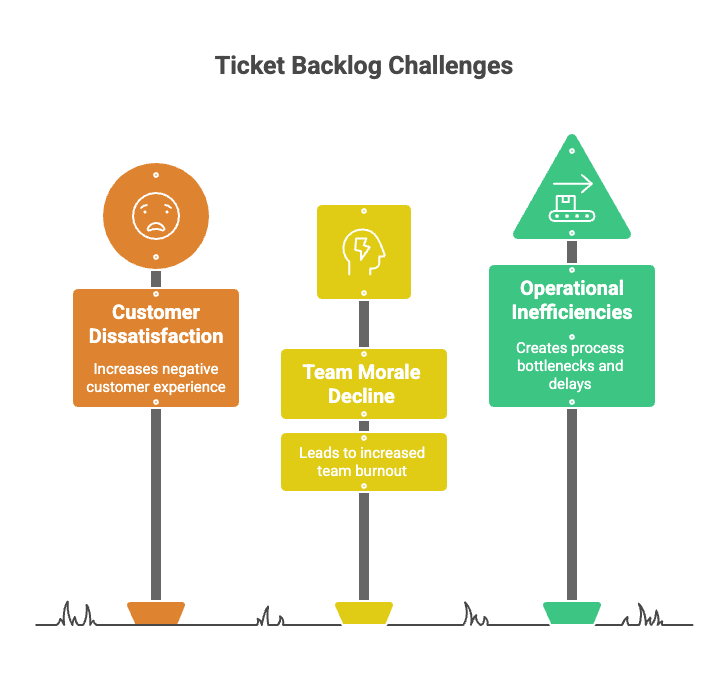
Your ticket backlog isn't just numbers on a dashboard — it's affecting every part of your business. The ripple effects spread from frustrated customers all the way to your team's morale and your bottom line.
Impact on customer satisfaction
Here's the thing about customer patience: it runs out fast. When tickets pile up, resolution times stretch longer, and that frustration builds quick. The numbers don't lie — 67% of customers will walk away from a company after bad customer service. That backlog you're looking at? It's directly connected to whether people stick around.
Speed expectations have gotten pretty intense too. 42% of customers want responses within 60 minutes, and a growing backlog makes that nearly impossible. What happens next is predictable — waiting customers start submitting multiple tickets or hitting you up on every channel they can find. Now you've got duplicate work on top of everything else.
Every day a ticket sits there unresolved, it costs you more. Customer perception drops with each passing hour, turning what might have been a quick fix into a loyalty problem. Get ahead of that backlog, and you can actually respond when people need you.
Effect on team morale and burnout
Behind every overwhelming ticket queue is a support team that feels buried. When agents face endless backlogs, stress turns into full burnout. This isn't just an HR headache — it hits your customers directly.
Support staff who feel constantly behind start rushing through tickets, spending less time actually solving problems. Quality tanks. Burned-out agents lose their edge in:
- Problem-solving abilities
- Empathy toward customers
- Response accuracy
- Overall performance metrics
The cycle gets worse from there. Growing backlogs create more pressure, leading to higher turnover and more absences, which creates even bigger backlogs. One industry expert calls it a "never-ending cycle of uncontrolled growth" where "the backlog feeds on itself".
Catching stress signals early lets you step in before things get serious. Adjusting workloads proactively keeps your operation balanced and prevents team overwhelm.
Operational inefficiencies
Think of your ticket backlog as a symptom of bigger operational problems. First off, it signals that resources aren't allocated right. Without proper backlog management, you can't figure out when you need more people or where to put them.
High ticket volumes hit your budget in multiple ways:
- More staff requirements
- Extra training costs
- Higher expenses for tools and systems
- Revenue lost from frustrated customers
Backlogs create workflow chaos too. Teams waste time jumping between tasks and trying to figure out what's actually urgent. All that context-switching kills momentum and slows everything down.
When tickets sit unresolved past your promised timeframes, you're breaking SLAs with partners and clients. Pretty soon, everyone loses visibility into what's happening, which breeds frustration and kills trust.
Bottom line: reducing your ticket backlog isn't nice to have — it's essential for business health. Streamline how you handle ticket resolution, and you'll optimize resources, cover high-demand periods better, and keep your whole operation running efficiently.
How to measure and track your ticket backlog
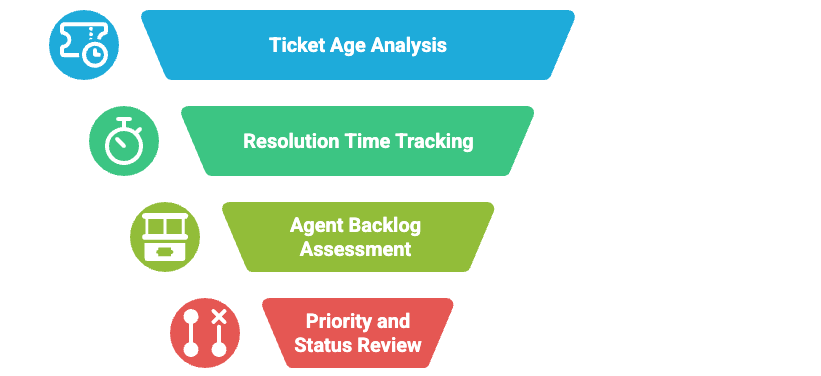
You can't fix what you can't see. Before you start tackling that growing pile of tickets, you need to understand exactly what you're dealing with.
Think of it like this: trying to manage your backlog without proper metrics is like driving at night without headlights. You might make some progress, but you're probably going to hit something along the way.
Number of unresolved tickets
Here's your starting point — total count of open tickets. This number tells you how many customer queries are sitting there waiting for help.
For level 1 support teams, track your average end-of-day backlog as a percentage of daily ticket volume. So if you handle 200 tickets daily with 10 still open at day's end, you're looking at a 5% backlog.
This percentage shows whether your team is keeping up or falling behind. A consistently rising backlog means you're losing ground, while stable or decreasing numbers suggest you're on the right track.
Most helpdesk systems show total unresolved tickets right on the dashboard, making this easy to monitor. Check this number daily — small problems become big headaches if you catch them too late.
Ticket age and resolution time
Some tickets have been sitting around way too long. Ticket age measures how long an issue has been unresolved since someone first reported it. This helps you spot which customers have been waiting the longest.
Break your ticket backlog into age buckets:
- Tickets less than 10 days old
- Tickets 10-30 days old
- Tickets older than 30 days
Here's what this might look like: a field services team handling 2,000 monthly tickets could have 200 tickets under 10 days old, 100 tickets between 10-30 days old, and 300 tickets exceeding 30 days. That breakdown tells you whether you're dealing with fresh issues or a bunch of forgotten cases.
Track your average resolution time too — the total time between ticket creation and closure. This helps you figure out what actually counts as "backlogged" for your team.
Backlog per agent
Not all team members handle the same workload. Calculate your backlog per agent coefficient with this formula:
Number of backlogged tickets ÷ Number of agents ÷ Number of tickets an agent can handle daily
A coefficient above 1 means your team is swamped and needs help. Below 1 indicates capacity for other tasks like training or documentation.
Here's a neat trick: publishing weekly reports showing each agent's backlog often cuts the backlog by 50% or more, since nobody wants to be at the top of that list.
Ticket priority and status
Not every ticket deserves the same attention. Categorize issues by priority levels based on urgency and business impact. Standard ITIL priority levels work like this:
- P1 (Critical): Affecting multiple users, complete system unavailability, resolution within 1-2 hours
- P2 (High): Significant impact with possible workarounds, resolution within 4-8 hours
- P3 (Medium): Limited business impact, resolution within 24-48 hours
- P4 (Low): Minimal impact, resolution within 3-5 days
Also track tickets by status to see where they stand in your workflow. Common statuses include New/Open, In Progress, Pending/On Hold, and Resolved/Closed. Status tracking reveals bottlenecks — if tons of tickets stay "In Progress" forever, something's wrong with your process.
These metrics give you clear visibility into what's actually happening with your support operations. Track them consistently, and you'll catch problems before they become crises.
Conclusion
Here's the thing about ticket backlogs — you can't just throw more people at the problem and hope it goes away. The strategies we've covered work because they tackle the root causes, not just the symptoms.
Think of it like this: if your backlog is a clogged drain, you don't want to just keep pouring more water down it. You need to clear out what's causing the blockage in the first place.
The good news? A small backlog isn't your enemy. It actually shows your team is busy without being overwhelmed. Your goal isn't zero tickets — it's finding that sweet spot where everything flows smoothly.
Start small. Pick one or two techniques from this blog and test them out. Maybe begin with analyzing what's really in your backlog, or set up some basic self-service options. Once those are working, add another piece to the puzzle.
The payoff goes way beyond just clearing tickets faster. Your customers get the help they need without the frustration. Your team stops feeling like they're drowning. And you start seeing patterns that help you fix problems before they become ticket floods.
We totally get that managing backlogs feels never-ending sometimes. But with the right approach, it becomes manageable — even predictable.
Your future self (and your support team) will thank you for taking action now instead of waiting for things to get worse.
6 proven ways to slash ticket backlog
Every unanswered customer query represents more than just a number—it's a frustrated customer and a stressed support team. When your ticket backlog grows uncontrollably, response times suffer, satisfaction drops, and burnout becomes inevitable. This comprehensive guide provides six practical strategies to transform your overwhelming support queue into a manageable, efficient operation.
- Analyze your backlog structure by categorizing tickets and identifying recurring issues that create the most work
- Improve self-service options with searchable knowledge bases, FAQs, and video tutorials to prevent tickets before they start
- Implement smart automation using AI chatbots, automated routing, and macros for repetitive responses
- Prioritize effectively by assessing urgency and impact, then routing tickets to the right team members
- Keep your team motivated with clear goals, recognition programs, and realistic workloads to prevent burnout
- Use real-time dashboards to track trends, monitor performance, and make data-driven decisions
Managing your ticket backlog isn't about achieving zero tickets—it's finding the sweet spot where your team operates efficiently without overwhelming stress. Start small with one or two strategies, then build your system gradually. The result: happier customers, motivated teams, and smoother operations that scale with your business needs.
Frequently Asked Questions
A high ticket backlog indicates that unresolved customer requests are piling up and can signal:
- Insufficient staffing or resources: Not enough agents to handle incoming tickets promptly.
- Inefficient processes: Slow workflows, poor ticket assignment, or weak prioritization.
- High ticket volume: More requests than the team can manage, possibly pointing to gaps in self-service options.
- Complex issues: Tickets taking longer to resolve due to complicated problems.
- Low agent productivity: Agents struggling due to lack of training, motivation, or proper tools.
Impact: Leads to longer response times, lower customer satisfaction, and increased churn, highlighting the need for better processes, staffing, or automation.
Ticket backlog is the number of unresolved tickets at a given time.
How to calculate:
- Count all open tickets in your system.
- Optionally, subtract tickets resolved during a period.
Example:
- Open tickets: 200
- Resolved this week: 50
- Backlog = 200 – 50 = 150 tickets
You can also track backlog by priority or age for better insights.
You should review your ticket backlog at least daily for urgent or high-priority tickets to make sure critical issues don’t slip through the cracks. For overall backlog trends and workload planning, a weekly review works well.
Some teams also do monthly or quarterly reviews to identify patterns, recurring issues, or staffing needs. The key is to balance immediate action with long-term backlog management.
- Prioritize urgent tickets
- Use canned responses for repetitive queries
- Set up self-service resources
- Spread workload across shifts
- Hire or scale team based on ticket trends
- Automate repetitive tasks
- Regularly review and triage
- Analyze root causes (product issues, billing errors, etc.)
